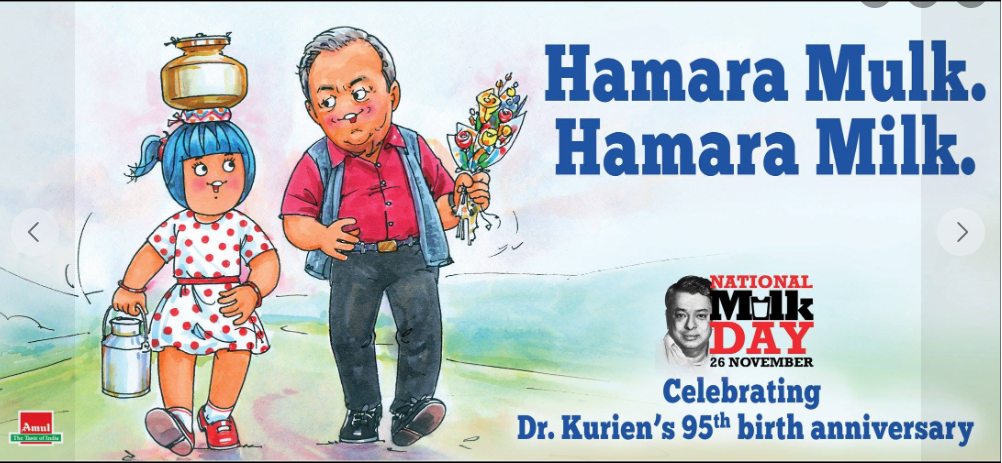Today, Amul stands tall as a perfect example of Indian brand renowned for its top-quality dairy products. Chances are, you have an Amul product in your home right now. The widespread adoration, trust, and usage of Amul products are a testament to its enduring success. Amul markets itself as the taste of India, however it could be called as one of the best marketers of India owing to its genius UGC marketing strategies.
How did Amul achieve this remarkable feat? It’s all thanks to their ingenious and consistently effective marketing strategy. In this article, we’ll delve into the details of Amul’s exceptional approach to marketing. Before we do, let’s explore a bit more about the company itself.
Background of Amul
Amul, an Indian dairy cooperative headquartered in Gujarat, operates under the ownership of the Gujarat Cooperative Milk Marketing Federation Limited, a part of the Department of Cooperation under the Government of Gujarat. With a staggering 3.6 million milk producers under its umbrella, Amul’s inception dates back to 1946 when Mr. Tribhuvandas Kishibhai Patel laid its foundation.

Verghese Kurien later joined as the general manager, overseeing the marketing and technical aspects of the cooperative. Following Mr. Patel’s passing in 1990, Kurien assumed the role of chairman and emerged as the face of Amul’s success.
Business Model & Revenue
The Amul business model is built on the principles of providing “value for money to the customers and protecting the interests of farmers simultaneously.” This model operates through a three-tiered structure in its dairy production process:
Direct Link between Producers and Consumers: Amul serves as a direct bridge connecting milk producers with consumers, eliminating the need for middlemen. This allows Amul to offer products at affordable prices.
Empowering Farmers: The farmers, who are the milk producers, hold control over the entire process including procurement, processing, and marketing. This means that they have a direct stake in the production and distribution of the dairy products.
Professional Management: While the farmers have control over the production process, Amul is managed by a team of professionals who oversee the operations and ensure efficiency in the business.
This business model has had a significant impact in the market. It not only enables Amul to offer quality products at reasonable prices but also ensures that the farmers receive fair compensation for their produce. This mutually beneficial approach has contributed to Amul’s success and popularity. In addition to this three-tiered structure, Amul operates on a cooperative basis, meaning there is no single owner of the company. Instead, it is managed collectively by the villagers through the Amul Cooperative Society. This unique structure ensures that decisions are made collectively for the benefit of all stakeholders.
The business model of Amul rests on five pillars:
- Milk Producers: These are the farmers who supply milk to Amul.
- Village Dairy Cooperation: This involves the local level cooperatives where milk is collected and processed.
- District Milk Cooperation Union: These unions oversee the operations in a specific district, coordinating the activities of multiple village level cooperatives.
- State Cooperative Milk Marketing Federation: At the state level, this federation handles the marketing and distribution of dairy products.
- The Consumer: The end consumer who purchases Amul products.
This inclusive model not only supports the livelihoods of farmers but also ensures that consumers have access to high-quality dairy products. It is this cooperative and value-driven approach that has made Amul a truly “for the people” company, resonating with both producers and consumers alike.
Target Audience
Amul caters to customers seeking high-quality products at affordable prices. To address the diverse needs of its audience, Amul divides its target market into two segments, allowing for tailored marketing strategies.
For Business to Consumers (B2C), Amul offers a wide range of products designed to suit different age groups and preferences:
- Kids: Amul milk, chocolate, Amul Kool, Nutramul
- Youngsters: Amul Pizza, Amul Pizza Cheese, Amul cheese spread
- Fitness Enthusiasts: Nutramul, Amul lite butter, Sugar/skimmed milk powder, Amul Shakti
While Amul’s television advertisements primarily focus on the B2C market, the brand places a significant emphasis on Business to Business (B2B) as well. The B2B category holds special importance for Amul, as these customers make bulk purchases and maintain regular business relationships, making them vital for the company’s success.
In the B2B category, Amul provides products to:
- Milk: Hotels, Ice cream stores, Cafes, and local food Vendors
- Butter, Ghee, Cheese, Paneer: Cafe, Bakeries, Restaurants, Food stalls, etc.
By strategically targeting both B2C and B2B segments, Amul ensures that it meets the diverse needs of its customers while maintaining strong partnerships with businesses in various industries. This approach allows Amul to deliver quality products and maintain a robust presence in the market.
Amul’s Marketing Campaigns
Amul stands out from its competitors through its innovative marketing tactics. Despite stiff competition in the dairy industry, Amul’s shrewd marketing campaigns have helped it emerge as a dominant player.
Amul’s Ad Girl Marketing Strategy
In 1967, Amul introduced an iconic hand-drawn girl in response to a rival brand. This endearing character has become a beloved figure in Indian advertising. The activities of this girl change in each ad, from practicing yoga to playing cricket. This strategy has proven to be one of Amul’s most effective marketing techniques.
Moment Marketing Strategy of Amul
Amul has been using moment marketing for decades, adapting to changing platforms. Initially in newspapers, it now leverages popular social media platforms like Twitter. By incorporating current events, such as the equal pay announcement for male and female cricketers, Amul demonstrates its agile and innovative marketing approach.

Low-Cost, High-Value Marketing Strategy
Amul’s target market encompasses the masses. By offering quality products at affordable prices, Amul has cultivated a loyal customer base. This straightforward yet impactful strategy has boosted customer retention rates and provides a competitive edge.
Smart Tagline Marketing Strategy
Amul’s well-known taglines, such as “Amul Doodh pita hai India” and “The Taste of India,” resonate with consumers. These taglines effortlessly capture consumer attention, showcasing the power of creativity and understanding consumer psychology without requiring a substantial financial investment.
Unified Branding Strategy
In a departure from the norm, Amul opted for a unified branding approach. Unlike other FMCG companies that use different brand names for their products, Amul established a flagship brand under which it markets a diverse range of products. This strategic move has leveraged the strength of the Amul brand, ensuring new product launches enjoy immediate success.
Amul’s success story is a testament to its astute marketing strategies. By embracing creativity, adaptability, and a customer-centric approach, Amul has not only withstood fierce competition but also emerged as a leading force in the dairy industry. These strategies serve as valuable lessons for businesses aiming to make their mark in competitive markets.
UGC Content Marketing
An integral element of Amul’s digital marketing strategy is its active presence on major social media platforms such as Facebook, Twitter, and Instagram. Through these channels, Amul shares captivating content that not only showcases its products but also reinforces its brand identity.
Email Marketing
Email marketing is a significant component of Amul’s digital strategy. The brand consistently sends newsletters and promotional emails to subscribers, providing updates on products, exclusive offers, and new releases. This approach serves as an effective means of keeping consumers informed and engaged.
Amul remains relevant and resonates with its audience. For instance, during the celebration of National Milk Day in 2019, Amul launched a campaign that included a bike rally covering a significant distance to engage with dairy farmers and honor the legacy of Dr. Kurien.

Additionally, Amul has effectively utilized Twitter to engage with customers. The brand shares fun graphics featuring the Amul Butter Girl, inviting customer interaction through contests and giveaways. Notably, Amul is also active on YouTube, leveraging its channel to re-broadcast advertisements previously aired on television.

During the COVID-19 pandemic, Amul demonstrated resilience and adaptability by implementing impactful marketing campaigns. One notable initiative was the “Simple Homemade Recipes” campaign. This effort invited chefs from various culinary backgrounds to showcase their skills using Amul products, garnering an extensive viewership.

By adeptly utilizing various digital platforms and seizing opportunities presented by current events, Amul has effectively connected with consumers in the digital landscape. These examples illustrate how Amul’s marketing strategies have not only endured but thrived in a rapidly evolving marketing landscape.
Key Takeaways
Amul has achieved the coveted top spot in Campaign Magazine’s esteemed list of the Top 1000 brands in Asia. Its journey from grappling with middlemen exploitation to becoming an essential product in every Indian household is truly commendable.
Through ingenious strategies that resonate with every Indian, Amul has carved a path to success. The clever integration of the ‘Amul Girl’ with current events, disseminated across various social media platforms, has firmly established Amul in the hearts and minds of its customers.
Get ahead in your marketing efforts with expert assistance. Visit our website for details or reach out to us via email at [email protected].




